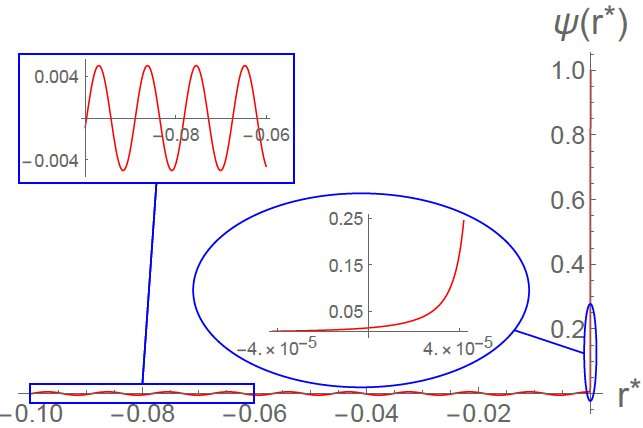The anti-de Sitter/conformal field theory (AdS/CFT) correspondence, also referred to as gauge/gravity duality, hypothesizes the existence of a relationship between two types of physics theories, namely gravity theories in AdS spacetimes and CFTs. Over the past few decades, gauge/gravity duality constructs have been applied in a wide range of scientific research fields. For instance, some researchers tried to use AdS/CFT to advance the development of a full quantum theory of gravity.
A team of researchers at the University of Maryland has recently explored the potential of this theoretical construct in cosmology studies. In a paper published in Nature Physics, they showed how previously proposed cosmological models could be microscopically realized by incorporating elements of AdS/CFT.
“Our work is set up at the intersection of two ideas,” Stefano Antonini, one of the researchers who carried out the study, told Phys.org. “The first is the AdS/CFT correspondence, one of the most studied frameworks for the formulation of a quantum gravity theory.”
AdS/CFT essentially theorizes the relation of a gravitational theory in an asymptotically AdS spacetime to a CFT that does not account for gravity and has one less dimension. Antonini and his colleague Brian Swingle asked themselves whether it was possible to describe the evolution of a cosmological universe using this theoretical construct, which had so far primarily been applied to other research topics.
“When trying to answer this question, a second idea came into play: The Randall-Sundrum model and its generalizations propose that our 4-D universe could be a 4-D membrane embedded in a 5-D asymptotically AdS spacetime,” Antonini explained.
The researchers’ study builds on ideas proposed in a previous paper by Swingle and other researchers, published in Springer Link’s Journal of High Energy Physics. This past study explored the possibility that certain high-energy holographic CFT states correspond to black hole microstates with a particular structure that terminated at an end-of-the-world (ETW) brane.

In string theory and other related physics theories, a brane is a dynamical object that can propagate through spacetime in accordance with quantum mechanics laws. In their new paper, the researchers wanted to identify a way in which Randall-Sundrum braneworlds could be studied in AdS/CFT correspondence by showing the existence of particular CFT states that are dual to charged black hole geometries involving an “end-of-the-world” brane living in the second asymptotic region, which emerges from and falls back into the black hole horizon.
“It is well-known that the motion of a 4-D brane in a 5-D AdS black hole spacetime looks like the evolution of a 4-D FLRW universe to an observer ‘living on the brane,’ who, like us, is not aware of the existence of the fifth dimension,” Antonini said. “For a brane-world model to be meaningful, however, such an observer must also perceive gravity to be effectively four-dimensional, as it is the case in the original Randall-Sundrum model. In the presence of a large black hole, however, this ‘gravity localization’ phenomenon is particularly troublesome to obtain.”
The model proposed by Antonini and his colleagues suggests that under appropriate conditions and for part of its evolution process, a brane sits far away from a black hole horizon and moves slowly. The researchers showed that in this particular regime, a gravitational perturbation remains locally bound to the brane.
This is because the perturbation is ‘trapped’ by a negative delta potential, which arises from the Neumann boundary conditions in the place where the brane is positioned. In other words, in this regime a hypothetical 4-D observer would interpret gravity to be 4-dimensional, as long as they do not try to probe very large spatial scales.
“There are two main achievements of this work,” Antonini said. “First, it showed the existence of charged black hole microstates, which allow a holographic dual description and involve at the same time an end-of-the-world brane sitting far enough from the black hole horizon to possibly support gravity localization. Secondly, we found that gravity is, indeed, locally localized on such brane-worlds.”
The ideas presented by Antonini and Swingle could ultimately open up new possibilities for describing quantum cosmology phenomena and simulating these on quantum computers. While so far, the researchers have only produced a toy model of their theory and much progress needs to be done before it can be effectively applied to cosmology problems, their work introduces a new way of studying cosmology in AdS/CFT correspondence and thus of investigating quantum gravity in a cosmological universe.
“We are now exploring the possibility of explicitly realizing our construction in the context of the charged SYK model, which is dual to a simple 1+1 dimensional gravitational model,” Antonini said.
More information:
Stefano Antonini et al. Cosmology at the end of the world, Nature Physics (2020). DOI: 10.1038/s41567-020-0909-6
© 2020 Science X Network
Citation:
Researchers apply the anti-de Sitter/conformal field theory to cosmology (2020, July 9)
retrieved 29 April 2023
from
This document is subject to copyright. Apart from any fair dealing for the purpose of private study or research, no
part may be reproduced without the written permission. The content is provided for information purposes only.

